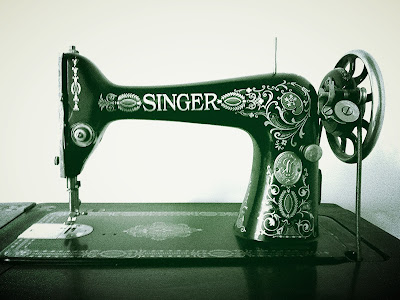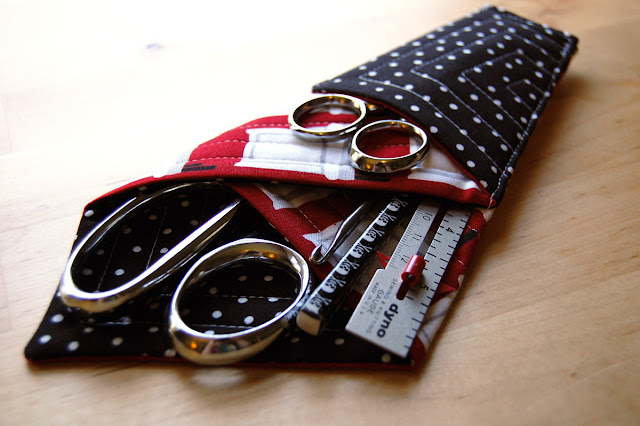Caring For Plastic/Acrylic Sewing Tools
How much plastic stuff is in your sewing room? If you've been sewing or quilting for awhile, you may have clear plastic rulers, templates, French curves, maybe even a sewing machine extension table. Another name for that clear plastic is acrylic, which you may know by trade names such as Plexiglas, Lucite, or Crystalline. Caring for your acrylic sewing tools the right way will help keep them all clean, scratch free, and can even extend the life of your tools.
First some quick DO'S and DONT'S for acrylic care:
DUSTING:
DON'T use paper towels or other abrasive cloths. DO use soft, clean 100% cotton rags (like all cotton t-shirts or old cloth diapers/burp cloths).
CLEANING:
DON'T use cleaning products that include abrasives, bleach or ammonia (Windex). DO use plastic-safe cleaning products like Sparkle or Plexi-Clean (both of which I find at my local Ace Hardware).
STORAGE:
DON'T store plastic items in direct sunlight for extended periods of time. DO store plastic items away from extended exposure to direct sunlight. DON'T store plastic items in a place where temperatures may fluctuate greatly, like an attic or outbuilding with no heat/air conditioning. DO store plastic items in an environment with stable temperatures, like in your home that has temperature control.
CARE OF RULERS/TEMPLATES
Clear acrylic rulers and templates come in many, many shapes and sizes. You can safely store them flat, or if your ruler comes with a pre-made hole you can hang them up on the wall (think pegboard!). You can store your rulers in an upright container or wall pockets as long as the rulers are properly supported; they should appear straight when stored, not bent or bowed.
Rulers and templates can be damaged from dropping (ask me how I know this!), like the one below...
 |
| Ooops! |
 |
| I've had this French Curve for over 20 years! |
Clean acrylic rulers by dusting occasionally with a soft 100% cotton cloth. If your ruler is really dirty and you need to use a cleaner, try some very mild soap and water, Sparkle, or another cleaner made specially for plastics. In very extreme cases where a ruler has lots of scratches, you may choose to use a plastic polish, which will buff out small scratches. Be sure to only use the plastic polish on the side of the ruler without the printed markings; the polish can take the numbers and marks right off of the ruler! In my case, as long as I can see what I need to see with the ruler, I don't do any polishing - I just keep them clean.
CARING FOR YOUR EXTENSION TABLE
Plastic extension tables are GREAT for creating more sewing space for stitching large projects or quilting. When not in use, store your extension table in an area where it won't get bumped or knocked over; store either flat or upright, and make sure it is not bent or bowed. If your extension table came with a cover, use it!
Clean by dusting with a soft cotton cloth. If you need to use a cleaner (like if you accidentally got some spray adhesive...or maybe chocolate) on the table, use mild soap and water, Sparkle, or another cleaner made specifically for plastics. You may find after lots of use that your table has small scratches from pins, or from repeatedly laying scissors on the table. As long as there are no plastic burrs sticking up from the scratches that could catch on fabric, it's only cosmetic and won't affect your sewing. If you really want to, you can use plastic polish to buff out some of the smaller scratches and bring back the shine to your table. Just like with the rulers, if there are markings underneath your table don't polish over them, you could buff the markings right off.
AND ONE MORE THING...
These days most sewing machines have plastic covers. You can follow some of the same general directions above for taking care of the outside of your sewing machine, but here are a few extra tips.
If your sewing machine has extra shiny plastic parts or metallic plastic, be extra vigilant about using a super soft cotton cloth to clean these parts to avoid dulling and scratching!
When using a spray cleaner (and as listed above, only use a plastic safe cleaner!), be sure to spray the rag and never directly on the sewing machine.
Be careful of cleaning computerized screens on your sewing machine! Use a cleaner specifically made for cleaning electronics, or check in your sewing machine user manual to see what the manufacturer suggests. Don't press too hard on the computerized screen, or use any cleaners with abrasives, bleach or ammonia that may cloud the screen.
YELLOWING PLASTIC
 |
| Plastic yellowing on 20 year old machine. |
Some plastics yellow over time due to the chemical composition of the plastic. Sometimes this process is speeded up by exposure to light (the same UV rays that cause sunburn). There's really not much you can do about yellowing plastic. I've read online that some people suggest bleaching yellowed plastic, but adding bleach may eventually do more harm by possibly changing the chemical composition of the plastic, making it brittle and fragile. It's only cosmetic, and as long as your machine is still in great working order, don't worry about a little "aging"!
 |
| Plastic casings starting to discolor. |
If your sewing machine with plastic parts is out in a sewing cabinet or table, make a cover for the machine - it will keep the dust off and prevent or slow down some of the yellowing that might take place over time. If you sew in a temporary area, make sure to put your sewing machine away when not in use. Thankfully, plastics have improved and I believe many manufacturers are using a higher grade plastic that resists yellowing over time.
Look for plastic safe cleaners, plastic polish, and 100% cotton cleaning cloths at your local hardware store (my local Ace Hardware has several cleaners and polishes made for plastics).
I hope these tips are helpful to you, and may your plastic sewing tools live long and prosper!








Comments